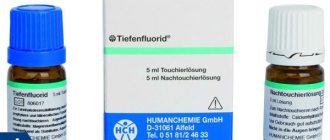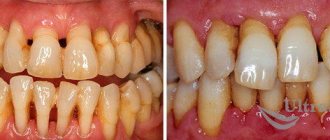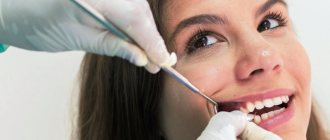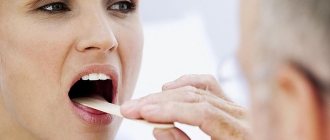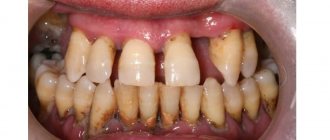Periodontal disease: features of the disease
Periodontal disease is an oral disease that affects the gums. Due to the narrowing of the blood vessels located in the soft tissues of the oral cavity, the supply of nutrients to the gums is reduced.
This leads to degeneration of the tissues around the teeth.
Periodontal disease is a rare disease. People who consult a specialist for problems with their gums are usually diagnosed with generalized periodontitis. That is, a disease that has already begun to destroy the periodontium.
With periodontitis, the gums become inflamed, they begin to bleed, and bad breath appears. In the early stages of periodontal disease, such symptoms are not observed. The mucosal tissues look healthy. Which makes diagnosing the problem difficult.
Ointments
The use of ointments is no less effective than the use of other drugs. Doctors advise using compounds that have antibacterial, anti-inflammatory, healing, analgesic and soothing properties. Ointments allow you to quickly get rid of the pain that occurs with periodontitis.
Let's look at the most common medications of this type:
- Holisal. It is most popular because this ointment has almost no contraindications. Promotes wound healing, relieves swelling, and actively coagulates bacterial cells. Can be used not only for adults, but also for children.
- Solcoseryl dental. It is also a very effective drug that promotes wound healing and improves blood flow in the gums. The components included in its composition help improve cellular metabolic processes and restore the cell membrane.
- Metrogyl denta. The ointment is considered very effective because it contains components that actively fight fungal, bacterial and viral infections. The drug contains two powerful components: metronidazole and chlorhexidine. The first is an effective destroyer of pathogenic microorganisms, the second is antimicrobial, helping to eliminate the disease.
Modern dentistry has an impressive number of drugs that allow you to treat periodontitis at home. But they all require a thorough professional diagnosis of the disease, which can only be carried out by a specialist.
The main causes leading to periodontal disease
At the moment, experts have made serious breakthroughs in the study of this disease. But scientists still cannot say that they have studied periodontal disease 100%. At the moment, it is believed that the main reason for the development of this disease is heredity. If at least one of the patient’s parents had this problem, then most likely it will be passed on to the child.
The immediate cause of the development of periodontal disease is a violation of metabolic processes. Disruptions in the body associated with changes in hormonal levels often lead to a decrease in the flow of beneficial substances to the gums. Other reasons worth noting:
- Disease of the gastrointestinal tract.
- Poor nutrition and poor diet.
- Diseases of a neurological nature.
- Alcohol and tobacco abuse.
- Decreased protective functions of the body.
Indirectly, the development of periodontal disease is affected by bite pathologies and mechanical trauma to the periodontium. The formation of plaque and tartar often triggers the onset of processes that will subsequently lead to periodontal disease.
How to treat periodontitis correctly:
Treatment of periodontitis will depend primarily on the severity of the inflammatory process in a particular patient. The more significant the level of bone loss and the degree of tooth mobility, and the more missing teeth you have, the more difficult, time-consuming and expensive the treatment will be. It all starts with a consultation, and you should not go to a regular dental therapist, but only to a periodontist (this is a doctor who specializes in the treatment of gum inflammation).
The author of this article has worked as a periodontist for more than 10 years, and therefore all our recommendations, which you will see below, really work (state-issued documents on advanced training in the Periodontology program can be viewed in the editorial section).
Consultation with a periodontist –
The first thing to do is make a treatment plan. This is not as easy to do as it might seem in reality. If the disease is mild, you may only need to consult a periodontist. However, in case of mobility and divergence of teeth, malocclusion, when there are already missing teeth or those that will definitely have to be removed, a joint consultation with an orthopedic dentist (prosthetist) is necessary.
X-ray diagnostics – for a full consultation, a panoramic X-ray will be required to assess the level of bone tissue destruction, location and depth of periodontal pockets. The image will allow you to make the correct diagnosis, which will include the severity of your disease. For the patient (whose panoramic image is shown below), the diagnosis will be as follows: “Chronic generalized severe periodontitis.”
Pay attention to the photo. You can notice that the level of bone tissue (looks like light, finely looped cellular tissue in the picture) is reduced in some teeth by 2/3 of the root length, and in a small number of teeth - only by 1/4. The patient has roots that need to be removed, as well as caries that requires treatment. It is especially noticeable that the bone level is maximally reduced in the front teeth of the upper and lower jaws, which is also due to their chewing overload (due to the absence of a large number of lateral teeth).
In similar situations, if a decision is made to preserve the front teeth, it is necessary to make a temporary removable denture as quickly as possible. It will replace missing teeth and relieve increased chewing load from the front teeth.
Removal of supra- and subgingival dental plaque –
The cause of periodontitis is soft microbial plaque, as well as supra- and subgingival dental plaque. Treatment cannot be effective without removing the causative factor, and therefore the basis of treatment for inflammatory gum diseases is high-quality removal of dental plaque. There are 2 main techniques that can be used in patients with periodontitis:
- ultrasonic teeth cleaning,
- Vector system.
How ultrasonic teeth cleaning is carried out (video) –
There are fundamental differences between ultrasonic scalers and the Vector system, but we do not want to overload this article with unnecessary information (therefore, you can read more about the Vector system at the link above). The only thing worth adding here is that at the 1st stage of treatment, in any case, you need to use only the classical ultrasound technique. And so to speak, “polishing the result” can be done in about 4-6 weeks using a Vector-Paro device, but it will cost 3-4 times more than conventional ultrasonic cleaning.
Important: in patients with periodontitis, it is simply impossible to remove all dental plaque in just 1 visit, and it is usually necessary to make appointments with patients several times. This is due to the fact that searching for and removing subgingival dental plaque requires a lot of time. In addition, the patient comes to the second appointment with less swollen and inflamed gums, which leads to a decrease in its volume, as well as, to a small extent, the depth of periodontal pockets. Accordingly, thanks to this, we will be able to look deeper on the 2nd visit and see subgingival tartar, which we had not previously noticed and missed.
In addition, it is important not only to remove subgingival tartar, but also, if possible, to polish the exposed surface of the tooth roots in the depths of periodontal pockets. The latter is done by careful movements of the ultrasonic tip nozzle, using special nozzles at low power. Otherwise, the rough surface of the root will contribute to the rapid formation of a new portion of subgingival tartar. In general, removing plaque from periodontitis is not easy, it is not quick, and it requires the patience and perseverance of a doctor, and by definition, this cannot be cheap. It will be cheap only if you remove the tartar “quickly”.
Anti-inflammatory therapy for periodontitis –
The course of anti-inflammatory therapy for periodontitis usually lasts 10 days. It is prescribed by a periodontist immediately after the 1st session of removing dental plaque. The course will necessarily include medications for local use in the oral cavity - these are antiseptic rinses and anti-inflammatory gel for the gums, which the patient will use at home. In addition, if there is purulent or serous-purulent discharge from periodontal pockets, antibiotics are prescribed internally.
ANTI-INFLAMMATORY THERAPY SCHEME:
It is prescribed by a dentist, and carrying out such anti-inflammatory treatment of periodontitis on your own is not at all difficult. The standard course of treatment lasts only 10 days. Treatment of gums should be carried out by the patient 2 times a day - morning and evening. It looks like this... In the morning, treatment is carried out after breakfast and oral hygiene (it is important - breakfast first, and only then brushing your teeth, and not vice versa). Likewise in the evening - first dinner, then brushing your teeth, and only then are antiseptic rinses and applications of gel to the gums.
So, after breakfast/dinner and oral hygiene, you must first perform an antiseptic mouth rinse with a 0.2% chlorhexidine solution (we will tell you why the standard 0.05% solution is not very effective for these purposes). To do this, you must take approximately 10 ml of solution into your mouth, which is 1 average sip. And then, without spitting anything, you should rinse your mouth for exactly 1 minute. Important: after an antiseptic rinse, you should not rinse your mouth with water.
Applying gel to the gums – the second stage of treatment is applying an anti-inflammatory gel to the gums. Over the 10 years of working as a periodontist, I have tried many different drugs, but I responsibly declare that Cholisal gel works best. An important point - before applying the gel to the gums, it is advisable to dry them with a dry gauze swab (it can be made from a bandage), because Any gel will adhere better to the dried mucous membrane.
The application of the gel to the gum is carried out in front of a mirror, and you must grin so that during the procedure you can see the edge of the gum and where exactly you are applying the gel. The gel must be applied with your finger - precisely on that part of the gums that is located around the necks of the teeth (gingival margin), and this must be done not only from the front surface of the dentition, but also from the palate / tongue. Now let's look at how exactly you need to apply the gel to the den.
If we are talking about treating the gums from the front surface of the teeth, then it is better to do it in two stages. First, you squeeze a little gel onto your finger several times and rub it into the gum margin with light massaging movements. Then squeeze the gel onto your finger again, and then apply it to the gum edge, without rubbing. As for the treatment of the gums from the side of the tongue/palate, it can be done once - only by rubbing small portions of the gel with light massaging movements.
Important: saliva will always be released during the application of the gel, and there is no need to accumulate it or spit it out. You must swallow it - as you usually do. In addition, after applying the gel to the gums, it is advisable not to drink anything for 30-60 minutes, and also not to eat or rinse your mouth for 2-3 hours. The second treatment of the day is carried out in the evening according to a similar scheme (dinner → brushing teeth → antiseptic rinse → gel application). And so on for 10 days.
An important question regarding the concentration of chlorhexidine is
There are clinical studies (source) that show the comparative effectiveness of different types of antiseptics and their different concentrations in the treatment of chronic generalized periodontitis. The fact is that in most patients with periodontitis, not only pathogenic bacteria live in periodontal pockets, but also fungal flora. The presence of fungal flora in periodontal pockets has a very important impact on the effectiveness of anti-inflammatory gum therapy in general.
Despite the fact that gum inflammation during periodontitis is caused directly by pathogenic bacteria, the presence of fungal flora makes these bacteria less sensitive to antiseptics and antibiotics. Accordingly, this requires the use of higher concentrations of antiseptics and antibiotics, which must be effective against both bacterial and fungal microflora. Only 2 antiseptics have these properties - either 0.2% chlorhexidine or 0.1% hexetidine (0.1% Hexoral solution).
Examples of great mouthwashes are:
Important: most often, concomitant fungal flora with periodontitis occurs in the following categories of patients. For example, if your gum inflammation is long-term, chronic, or you smoke, or eat a lot of carbohydrates, or have concomitant chronic tonsillitis, or you have gastrointestinal diseases, or you have had at least 1 case of candidiasis in the past ( thrush) of any localization.
In all these cases, you should not use 0.05% chlorhexidine to rinse your mouth with periodontitis, but rather purchase a 0.2-0.25% chlorhexidine solution (in such concentrations it is highly effective, including against fungi of the genus Candida). Such concentrations of chlorhexidine are contained in rinses - Parodontax Extra, Lacalut Activ and PresiDent Professional. For more information about choosing agents for the treatment of periodontitis, read the articles at the links below.
→ The best mouth rinses for periodontitis, → Rating of the best gels for gums.
Systemic antibiotic therapy –
If you have periodontitis, you can’t just take and start drinking any antibiotic, because... it is necessary to take into account the nature of the microflora in periodontal pockets. There are 2 options here: either prescribe a broad-spectrum antibiotic, or first culture the contents of the periodontal pocket for microflora. However, culture is always recommended for patients with aggressive periodontitis and vertical type of bone resorption. For more information about the choice of antibiotics and their dosage regimens, read the article:
→ Choice of antibiotics for gum diseases
Sanitation of the oral cavity and depulpation of teeth –
In parallel with the removal of dental plaque and anti-inflammatory therapy, it is necessary to begin treatment of carious teeth and removal of decayed teeth. At this stage, temporary splinting of mobile teeth can be carried out, as well as restoration of missing teeth with a temporary removable denture (to urgently relieve the mobile teeth). In addition, a very important point is the need for tooth depulpation.
For example, it is necessary to remove nerves from teeth with deep periodontal pockets (having a depth of more than 1/2 the length of the root). It is ideal when, before filling the root canals in these teeth, the “copper-calcium depophoresis” technique is also performed, but it is advisable to do such a procedure only in those teeth that have mobility. This allows you to disinfect all microscopic branches of the root canals inhabited by pathogenic bacteria. The combination of “depulp removal + depophoresis” can significantly reduce tooth mobility (provided that the traumatic bite is also neutralized).
Everything we said above is only basic treatment. Depending on the specific clinical situation in the oral cavity, other methods of treating periodontitis may be used. This may include splinting mobile teeth with fiberglass, surgical techniques (curettage and flap operations), the manufacture of temporary and permanent dentures, as well as selective grinding of teeth.
Splinting for periodontitis –
Splinting of mobile teeth is usually carried out in the presence of their mobility. This technique allows you to strengthen your teeth, quickly reduce inflammation, and also stop the progression of bone tissue destruction around these teeth. Splinting can be temporary or permanent, and can be done using fiberglass or artificial crowns “soldered” together. In Fig. 12-14 you can see the beginning of the splinting process, and the fiberglass tape laid on the lingual surface of the lower teeth (later it will be covered with a light composite).
Read about the features of this method and its cost in the article: → Splinting of mobile teeth for periodontitis
Surgical treatment of periodontitis –
It must be said that this is one of the most important methods used in the complex therapy of periodontitis, the use of which can really stop the progression of this disease. There are several methods of surgical treatment, which include open curettage, as well as flap operations. The purpose of surgical intervention is to remove all dental plaque from under the gums, clean out all inflammatory granulations (which form at the site of destroyed bone tissue), and ultimately eliminate periodontal pockets.
Such operations are performed by dental surgeons specializing in periodontics. The operations are complex and require diligence and skill from the doctor, so there are very few good specialists in this field. In Fig. 15-16 you can see a fragment of the open curettage operation. The gum is detached from the teeth, the edge of the bone tissue is slightly exposed, the inflammatory granulations have already been cleaned out, but the deep periodontal pocket in the canine area is clearly visible (which in the second photo is filled with osteoplastic material, which will partially restore the bone level).
Read more about this treatment method in our article: → Curettage for periodontitis
Prosthetics for periodontitis –
Orthopedic treatment of periodontitis is carried out in those patients who have missing teeth, or the method of splinting mobile teeth using artificial crowns has been chosen. This stage of treatment is essentially the final one (not counting subsequent periodic maintenance therapy), and the prognosis of the teeth will largely depend on it. The goal of the orthopedic stage of treatment is to restore the chewing efficiency of the dentition, reduce the chewing load on weakened teeth, thereby preventing displacement, protrusion or fan-shaped divergence of teeth.
As we said above, prosthetics can be temporary or permanent. Temporary prosthetics with a removable denture are necessary when a large group of teeth is missing. Such a prosthesis will reduce the load on the remaining teeth, increase the effectiveness of anti-inflammatory therapy, reduce tooth mobility, and also stop bone destruction. In addition, if curettage or flap surgery is planned, then ignoring the need for temporary prosthetics in such a situation can only lead to an increase in tooth mobility, as well as to stimulation of horizontal bone resorption in the operation area.
Classification of periodontal disease
The disease is divided according to the nature of treatment and the area affected. Periodontal disease can be acute or chronic. Since periodontal disease does not cause pain, this disease is called acute. This form of periodontal disease is extremely rare, but can lead to tooth loss in just a couple of years.
Depending on the affected area, periodontal disease can be:
- Localized. Damage to the gums occurs in a small part of the oral cavity. It affects the area of one to several teeth.
- Generalized. The disease affects the entire upper or lower dentition. In rare cases, the patient experiences periodontal disease in both jaws.
Diagnostics
The presence of at least one of the above symptoms should be a reason to contact the clinic, where a more thorough examination will be carried out. Doctors at our clinic only need a simple examination to make a preliminary diagnosis. A comprehensive diagnosis of periodontitis includes a number of diagnostic procedures that are necessary to clarify the extent of the disease and differentiate it from other diseases. Diagnostic procedures:
- Probing of periodontal pockets.
- Orthopantomogram is necessary to assess the degree of destruction of the jaw bones.
- Calculation of periodontal indices.
- Bacterial culture or PCR of the detachable gingival pocket.
- Schiller-Pisarev test.
To clarify the cause of periodontitis, you may need the results of other examination methods: biochemical and general blood tests, glucose level testing, and others. Gastroenterologists and endocrinologists are often involved as consultants, since without adequate treatment of somatic pathology, the treatment of periodontitis is very difficult.
Symptoms and stages of the disease
Symptoms of periodontal disease depend on the stage of the disease:
- Initial stage. At this stage, even an x-ray cannot reveal processes that negatively affect the tissues of the oral cavity.
- First stage. The gums recede. An experienced dentist can immediately identify the problem. The patient at this stage of the disease notices an increase in tooth sensitivity. The first changes can already be seen on the x-ray.
- Second stage. The neck of the tooth is exposed, and the patient often experiences discomfort when eating cold or hot foods. Gaps appear between the teeth, and periodontal tissues change color.
- Third stage. The upper part of the tooth root is exposed. The teeth themselves begin to loosen. The likelihood of them falling out increases.
- Fourth stage. Teeth cannot perform their functions. The patient's diction is impaired, eating food becomes extremely difficult.
Prevention and treatment of periodontal disease using “Solnyshko” devices
Ultraviolet quartz irradiators “Solnyshko” allow for the prevention and treatment of periodontal disease. The following models are well suited for this purpose:
- OUFv-02
- OUF-10-2
The device fights oral infections. To treat this disease, it is necessary to carry out 6-8 procedures of 10-15 minutes each. During this time, the patient must treat the surface of the gums using a special nozzle. This must be done extremely carefully. So as not to damage the soft tissues of the oral cavity.
“Solnyshko” devices are a universal technique for diagnosing and treating many ailments. They cope with bacteria and other microbes that lead to infectious diseases. This helps relieve the body's immune system and direct it to solving other problems.
